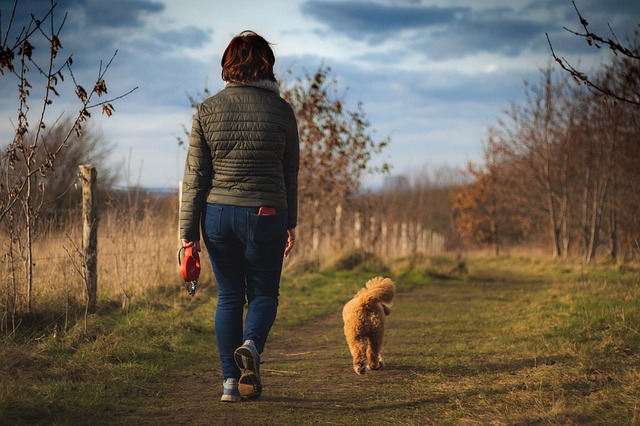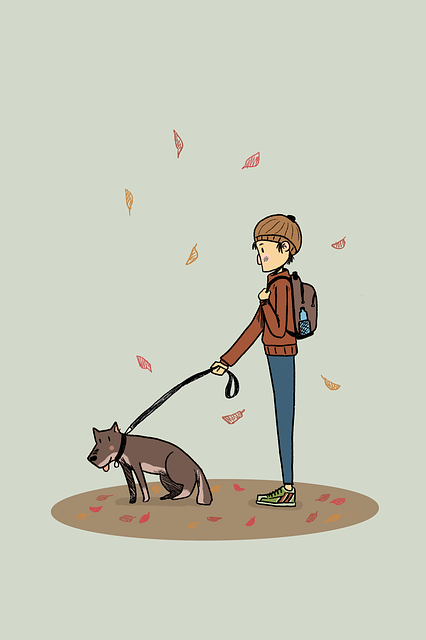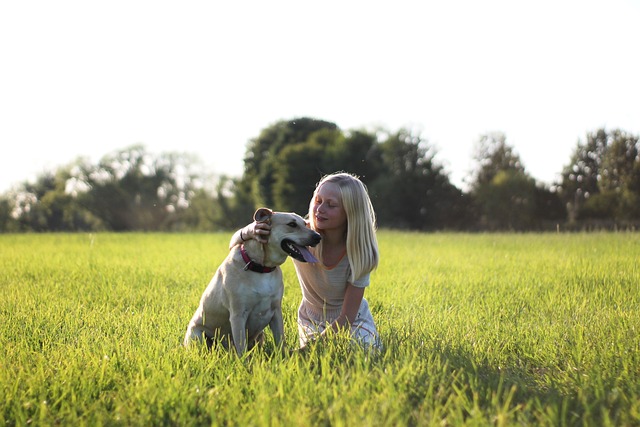The best time to take your dog for a walk is early morning or evening when temperatures are cooler. This helps prevent overheating and provides a more enjoyable experience for both you and your furry friend.
Taking your dog for a walk is not only essential for their physical health but also crucial for their mental well-being. It provides them with exercise, socialization, and mental stimulation. By choosing the right time to walk your dog, you can ensure they get the most out of their outdoor adventures.
Whether it’s a brisk morning stroll to start the day or a leisurely evening walk to wind down, finding the perfect time for your dog’s walk will strengthen your bond and keep them happy and healthy.
Benefits Of Regular Dog Walks

Enhance your dog’s well-being with daily walks, providing physical exercise and mental stimulation. Optimal times for walks are early morning or evening to avoid extreme temperatures. Regular walks can strengthen the bond between you and your furry companion.
Regular dog walks are essential for the physical and mental well-being of your furry friend. Not only does it provide a necessary exercise routine, but it also stimulates their mind and helps improve their behaviour. Let’s dive deeper into the benefits of regular dog walks.
Physical Health Perks
Walking your dog regularly helps keep them in shape and maintain a healthy weight. Obesity is a common health issue among dogs, and it can lead to several other health problems such as joint pain and heart disease. By taking your dog for a walk, you are providing them with the necessary exercise to keep their muscles and joints healthy. Additionally, regular walks can help improve your dog’s digestive system and reduce the risk of constipation.
Mental Stimulation And Behaviour
Dogs are naturally curious animals, and regular walks provide them with the mental stimulation they need. Walking your dog in different environments and allowing them to explore their surroundings can help reduce boredom and prevent destructive behaviour. Dogs that don’t get enough exercise may become restless and anxious, leading to behavioural issues such as chewing or barking. Regular walks can help reduce stress and anxiety levels in dogs, leading to a happier and calmer pet.
In conclusion, regular dog walks are essential for the physical and mental well-being of your furry friend. By providing them with the necessary exercise and mental stimulation, you can improve their behaviour and overall health. So, grab your leash and take your dog for a walk today!
Understanding Your Dog’s Breed And Energy Levels

Finding your dog’s breed and energy levels helps determine the ideal time for a walk. Matching their energy with the right exercise routine ensures a happy and healthy pup. Understanding your dog’s needs is key to providing the best care and companionship.
High-Energy Breeds
Low-Energy Breeds
When deciding the best time to take your dog for a walk, it’s essential to consider their breed and energy levels. Different breeds have varying exercise needs, so understanding your dog’s specific requirements is crucial for their overall well-being.
High-Energy Breeds:
— Breeds like Border Collies and Siberian Huskies require vigorous exercise.
— They thrive on activities like running and playing fetch.
— For these breeds, aim for long walks or intense play sessions.
Low-Energy Breeds:
— Bulldogs and Basset Hounds are examples of low-energy breeds.
— They prefer shorter walks and gentle activities.
— Consider calm strolls or light playtime for these breeds.
Understanding your dog’s breed and energy levels is key to ensuring they get the right amount of exercise. Adjusting your walking routine based on these factors will keep your furry friend happy and healthy.
Assessing The Weather Conditions

Assessing the weather conditions before taking your dog for a walk is crucial to ensure their safety and well-being. From hot and humid days to cold and rainy weather, understanding how different weather conditions can affect your dog is essential for a pleasant and comfortable walk.
Hot And Humid Days
On hot and humid days, it’s important to consider the temperature and humidity levels before taking your dog for a walk. High temperatures can lead to heat exhaustion and dehydration in dogs, especially those with thick coats or short noses. Avoid walking your dog during the hottest part of the day and opt for early mornings or late evenings when the temperature is cooler. Keep your dog hydrated and watch for signs of overheating, such as excessive panting or lethargy.
Cold And Rainy Weather
During cold and rainy weather, it’s essential to keep your dog warm and dry. Invest in a quality waterproof coat to protect your dog from the rain and cold winds. Check their paws for ice build-up or irritation from salted side walks. Limit the duration of walks in freezing and ensure your dog has a warm and dry place to rest afterwards.
The Ideal Time Frames For Dog Walking

When it comes to taking your furry friend for a walk, the timing can significantly impact their overall well-being. The ideal time frames for dog walking can ensure that your pup gets the exercise and mental stimulation they need to stay healthy and happy. Whether it’s early morning or in the evening, each time frame has its unique benefits for both you and your dog.
Early Morning Benefits
Taking your dog for a walk in the early morning has several advantages. The cooler temperatures are more comfortable for your dog, and the streets are often quieter, providing a peaceful environment for your walk. Additionally, the morning walk can set a positive tone for the rest of the day, giving your dog a sense of routine and structure. This can lead to improved behaviour and reduced anxiety throughout the day.
Evening Walk Advantages
Walking your dog in the evening also offers its set of benefits. After a day of rest, your dog may have built up energy and be ready for a good walk. Additionally, an evening walk can help your dog wind down and relax before bedtime, leading to a more restful night’s sleep. The cooler temperatures in the evening can also be more comfortable for both you and your furry companion.
Scheduling Walks Around Feeding Times
When it comes to scheduling walks for your dog, it’s important to consider their feeding times. Timing walks around meals can have a significant impact on your dog’s well-being and behaviour. Let’s explore the best times to take your dog for a walk in relation to their feeding schedule.
Pre-meal Walks
Taking your dog for a walk before their meal can be beneficial for their digestion and overall health. Engaging in physical activity before eating can help stimulate their appetite and ensure they are ready to consume their meal. Additionally, a pre-meal walk can help prevent your dog from feeling too full and lethargic after eating. It’s a good idea to schedule a walk at least 30 minutes before their mealtime to allow them to work up an appetite.
Post-meal Digestion
After your dog has finished their meal, allowing time for digestion before engaging in physical activity is crucial. Walking immediately after eating can lead to discomfort and potentially cause digestive issues such as bloating or stomach upset. It’s recommended to wait at least 30 minutes to an hour after your dog has finished eating before taking them for a walk. This will give their body enough time to start the digestion process and reduce the risk of any discomfort during the walk.
Balancing Your Dog’s Needs With Your Schedule
When it comes to taking your dog for a walk, finding the best time can be a balancing act. As a working professional, it can be challenging to align your dog’s exercise needs with your busy schedule. However, creating a consistent routine is key to ensuring that your furry friend gets the physical activity and mental stimulation they require.
Working Professional’s Dilemma
As a working professional, finding time to take your dog for a walk can be a real dilemma. Balancing your work commitments with your pet’s needs is crucial for their well-being. It’s important to find a time that fits into your schedule while ensuring your dog gets the exercise and stimulation they require.
Creating A Consistent Routine
Establishing a consistent routine for walking your dog is essential. Dogs thrive on routine, so try to schedule walks at the same time each day. This helps them anticipate and look forward to their daily outing. Consistency also helps regulate their energy levels and behaviour, making it easier to manage their needs within your busy schedule.
Seasonal Considerations For Dog Walking
When it comes to taking your dog for a walk, considering the seasonal factors is crucial for their well-being. Different weather conditions can have varying effects on your furry friend, so it’s important to tailor your walking routine accordingly. Here are some seasonal considerations to keep in mind for the best time to take your dog for a walk.
Summer And Heat Sensitivity
In the summer months, the heat can pose a serious threat to your dog’s health. Dogs are susceptible to heatstroke, dehydration, and burnt paw pads, so it’s essential to take precautions when walking them in hot weather. Here are some tips to keep your dog safe during summer walks:
- Walk your dog during the cooler parts of the day, such as early morning or late evening.
- Carry water and a portable bowl to keep your dog hydrated.
- Avoid walking on hot pavements or surfaces to prevent paw burns.
- Watch out for signs of heat exhaustion, such as excessive panting, drooling, and lethargy.
Winter Walk Safety Tips
When the temperatures drop, it’s important to ensure your dog stays safe and comfortable during winter walks. The cold weather can present its set of challenges, so here are some winter walk safety tips to consider:
- Keep your dog warm with a suitable coat or jumper.
- Protect their paws from ice and salt by using booties or paw balm.
- Be mindful of icy patches and slippery surfaces to prevent accidents.
- Limit outdoor time in freezing and watch for signs of frostbite.
The Role Of Age In Determining Walk Timing
Different age groups of dogs have specific needs when it comes to their walking schedules. Understanding the role of age in determining the best time to take your dog for a walk is crucial for their overall well-being.
Puppy Walking Schedules
Puppies require frequent short walks to help with their development. A general rule is to walk them for 5–10 minutes per month of age, up to twice a day.
Senior Dog Walking Needs
Senior dogs may have limited mobility and energy levels, so it’s important to adjust their walking schedule accordingly. Shorter, more frequent walks are beneficial for them.
Observing Your Dog’s Preferences And Signals
Observing your dog’s preferences and signals is crucial when deciding the best time to take them for a walk. While some dogs enjoy early morning walks, others prefer late afternoon or evening walks. Understanding your dog’s cues will help you determine the right time to take them out for a walk.
Understanding Your Dog’s Cues
Dogs communicate through body language, and it’s essential to learn to read their signals to know when they’re ready for a walk. Some signs that your dog is ready for a walk include:
- Tail wagging
- Excitement
- Bringing you their leash or toys
- Scratching at the door or barking
On the other hand, if your dog seems lethargic, uninterested, or is sleeping, it might not be the best time to take them for a walk.
Adjusting Walks To Your Dog’s Health
It’s important to adjust your dog’s walks according to their health. Older dogs or dogs with health conditions might not be able to walk for long periods or in extreme temperatures. In such cases, it’s best to take them for short walks during cooler times of the day. Similarly, younger and more energetic dogs may require longer walks and more exercise.
Consider the weather conditions when deciding on the best time to take your dog for a walk. During hot weather, it’s best to take your dog out early in the morning or late in the evening when temperatures are cooler. During colder months, it’s essential to keep your dog warm and dry to avoid health problems.
| Best time to walk your dog | Reason |
|---|---|
| Early morning or late evening | Cooler temperatures during hot weather |
| During daylight | Better visibility and safety |
| Short walks during extreme weather | Protecting your dog’s health |
Observing your dog’s preferences and signals and adjusting their walks according to their health is essential for their well-being. By doing so, you can ensure that your dog stays healthy and happy while enjoying their walks to the fullest.
Frequently Asked Questions
Is It Better To Walk A Dog In The Morning Or Evening?
It is beneficial to walk a dog in both the morning and evening to provide exercise and mental stimulation.
What Time Of Day Is It Best To Take Your Dog For A Walk?

The best time to take your dog for a walk is in the early morning or evening to avoid hot temperatures.
What Is A Good Walk Time For A Dog?
A good walk time for a dog is around 30 minutes to 2 hours, depending on the breed, age, and energy level. Regular walks help maintain their physical and mental well-being. Adjust the duration based on your dog’s individual needs and consult a vet if unsure.
What Time Of Day Do Most People Walk Their Dog?
Most people walk their dogs in the morning and evening. This is when the temperature is cooler, and it’s more comfortable for both the dog and the owner. However, it ultimately depends on the individual’s schedule and lifestyle.

Finding the best time to walk your dog depends on your schedule and their needs. Listen to your furry friend’s cues and choose a time that works for both of you. Remember, consistency is key for a happy and healthy pup!
